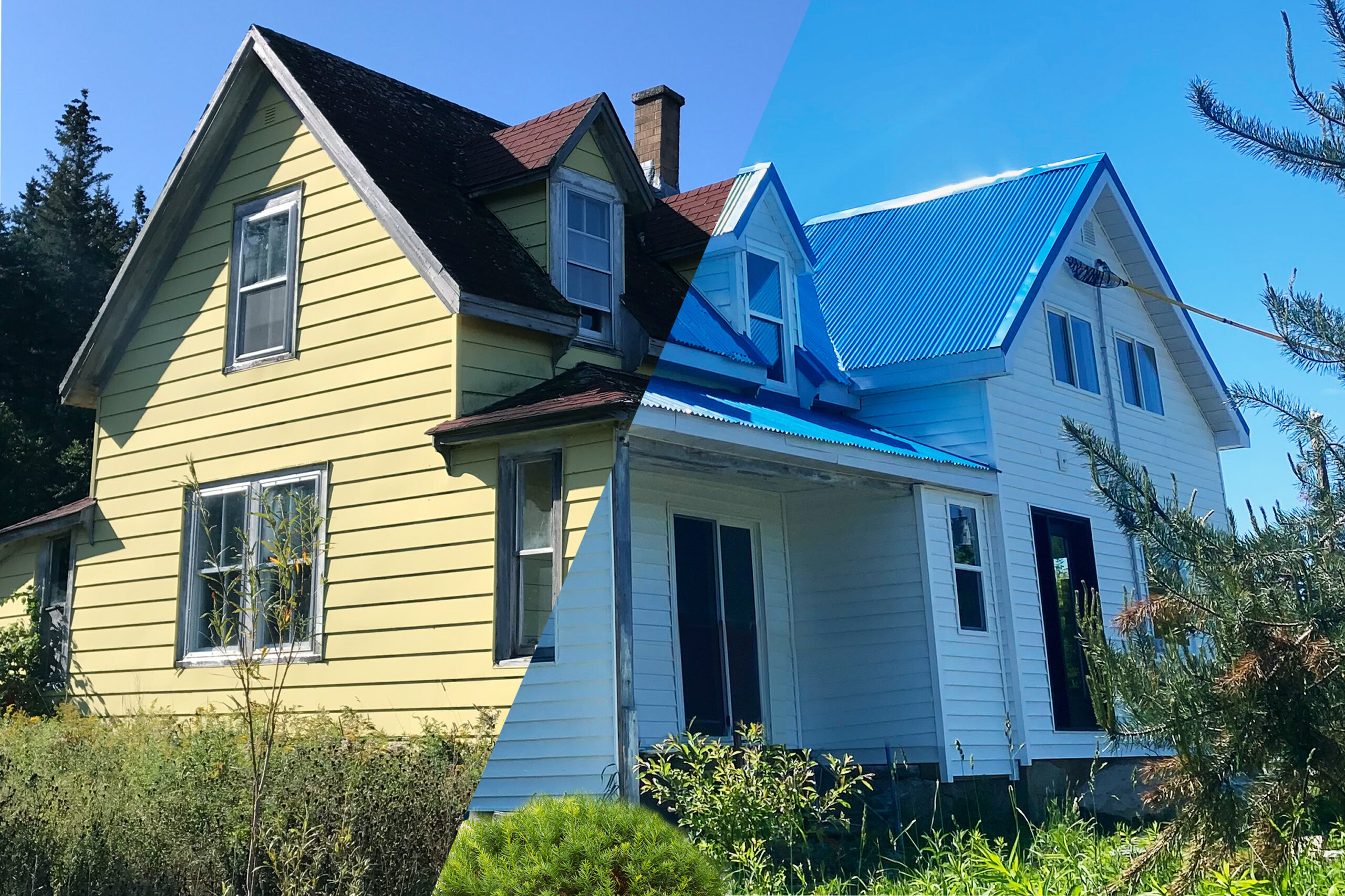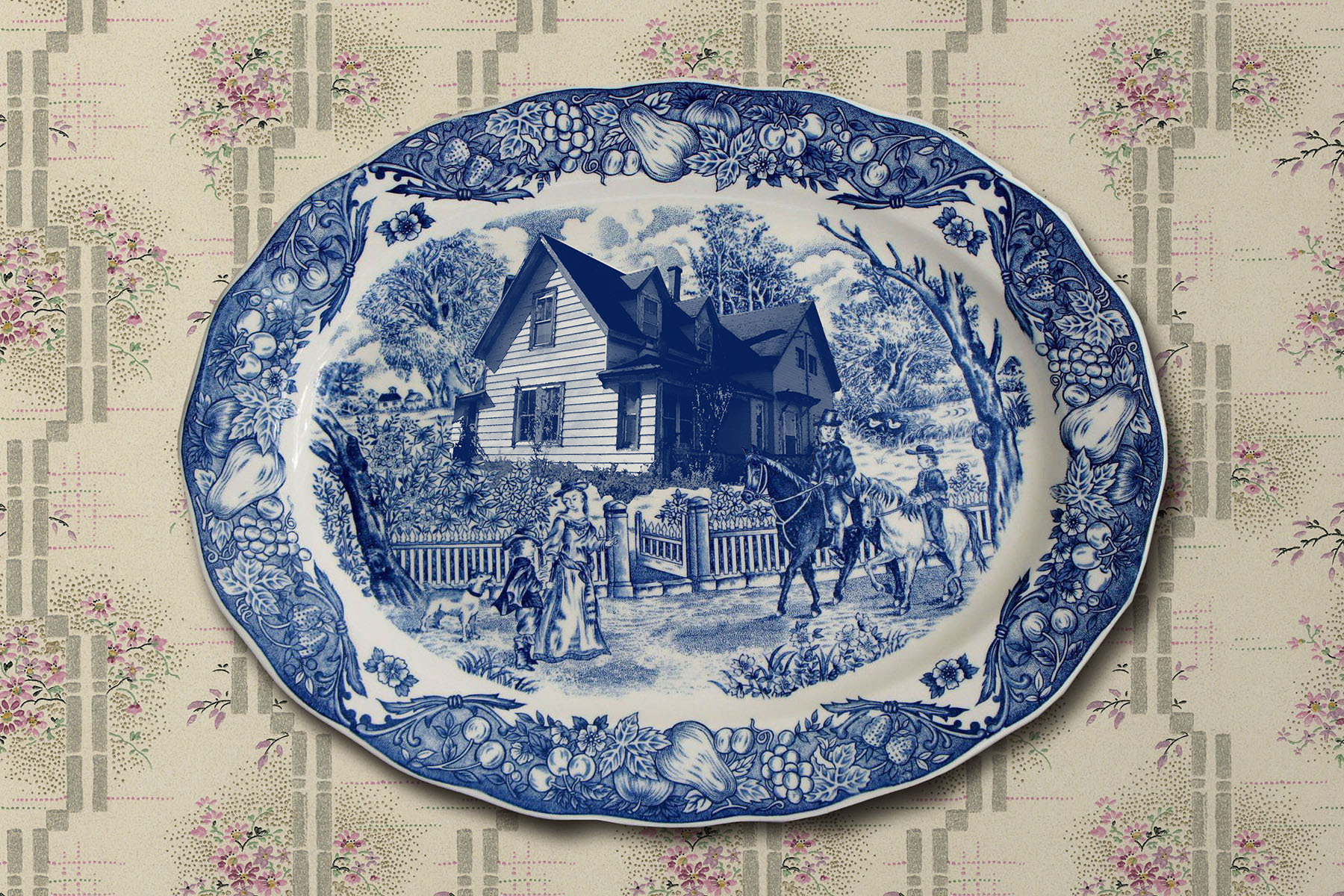To what lengths would you go to be a homeowner? Personally, I’ve been going pretty hard at it. Nearly every day for the past year, I’ve been waking up around 7 a.m., throwing on some work clothes, and getting ready for a day of construction. In my parents’ kitchen, I brew coffee while my dad makes us sandwiches for lunch. Then we hit the road, turning on CBC Radio as we make the twenty-nine-minute drive to my once-abandoned farmhouse.
Decades ago, the old yellow farmhouse was full of life. It was built in the 1820s. Highland cattle have roamed the mountainside, and apple trees around the property have blossomed every spring. Behind the house, lumber was once milled for the coal mine. But as the years passed and families shuffled in and out, the farmhouse was left behind. Before we knew it, twenty years had gone by and the farmhouse fell into disrepair, having weathered many storms and become a safe haven for raccoons and squirrels. On the outside, broken windows complemented a red-shingled roof with cavernous holes. Water seeped in, turning the staircase green and rotting the wooden floorboards beneath. Giant holes in them threatened to deposit you into the dug cellar below.
That’s the state the farmhouse was in when I bought it from my parents. To most people, it was a total teardown. Beyond help. But I saw potential. I always had it in my head that I would renovate my family’s farmhouse someday. I just didn’t know it would be the most straightforward way to become a homeowner.
Growing up in Cape Breton, Nova Scotia, I was never particularly worried about being able to buy a house. It’s not Toronto, or Vancouver, or even Halifax. Housing was never a pressing issue here. In October 2019, the average price of a residential house in Cape Breton was, by some estimates, $122,617. Before COVID-19, Cape Breton was not a happening spot. The population had been consistently falling for more than forty years. But during the pandemic, there was an influx of people who were leaving their cities and coming to my hometown. Suddenly, they wanted to live here.
According to the province’s finance department, in 2023, the Cape Breton Regional Municipality—CBRM—was the fastest-growing area in Nova Scotia, with a population increase of 6.7 percent—surpassing even Halifax, which clocked in at just over 4 percent. The municipality’s growth was due to an explosion of non-permanent residents moving here to study at Cape Breton University and an increase in newcomers more generally. In small Nova Scotia communities like my own, we’re experiencing daycare and doctor shortages, which haven’t been helped by the population growth.
I watched in horror as the housing market in Cape Breton seemed to catch fire overnight. Since 2021, I’ve been unsuccessfully searching for starter homes in my budget throughout Cape Breton. By 2023, after living with my parents for two years, I had saved up for a down payment. But by this time, interest rates had skyrocketed and housing was in short supply.
It has gotten downright difficult to purchase a house here—especially for cash-strapped young people like myself. It’s not just small communities, of course. More than half of Canadians aged twenty to forty have given up hope of ever owning a home. (But if you’ve just sold a house in Toronto and moved here . . . well, jeez, you’d have your pick of the litter.)
Data from the Canadian Real Estate Association shows that the average home selling price in the CBRM rose to $196,000 between October 2020 and October 2021—nearly a 20 percent increase. Now, that number is $262,775, as of July. That’s an uptick of more than $60,000 in just four years.
Even the most modest (read: horrible) houses in my area shot hopelessly out of my budget. One that’s twenty minutes from town and sold for a measly $40,200 in 2016 was listed for an unbelievable $139,900. My friends who managed to buy a house in the past few years did so through word of mouth, a back-door Facebook Marketplace deal, or by offering over asking price. Not one but two of my friends purchased their homes because their moms knocked on a door after hearing the homeowner had passed away. If I hoped to own a home here, I had to get crafty and pick up the power tools.

Given the state of the housing market, I looked at the farmhouse and thought: Hey, here’s a perfectly good home. Sure, there are holes in the floor, raccoons in the crawl space, and water coming in through the roof. But what other choice did I have? I had been living with my parents for three years already, and I didn’t want to continue doing that into my thirties.
I bought the decrepit house last November. (For $1. Call me a housing nepo baby.) I had a vision of turning it into my first house, using my down payment money—about $50,000—to renovate it. Last October, we started with the demolition. We gutted the house back to the studs; we ripped out the old electrical wires, rotted floorboards, and plumbing. We jacked up the house from the basement and watched it jump, then settle. We reinforced the floor joists and hauled out mouldy plasterboard adorned with several layers of wallpaper. My dad and I did almost everything ourselves, but we hired friends sparingly to do manual labour, plumbing, and electrical work. I sourced windows from family members, bought used doors from the hardware store, and tried to recycle materials whenever possible.
There were challenges, of course. In January, temperatures dropped to minus twenty degrees with the wind chill. We attempted to fix the leaky dormers as my toes turned into little ice cubes. Rain seeped through the roof, forming a puddle on the floor that made me want to cry. In July, temperatures neared thirty-eight degrees on the humidex as we hauled drywall upstairs. There were also moments of beauty. When we installed the metal roofing, I climbed up to the peak of my house. For days, I overlooked the brilliant blues and indigos of the Bras d’Or Lake.
Since October, we have replaced every window and door, insulated the house from the outside, and installed new siding. We ripped down two crumbling chimneys. We admired the 1800s-era hand-hewn beams, the birch bark and newspaper insulation in the walls. We found plastic bags shoved into crevices to stop cold air from passing through and replaced them with insulation. With every improvement, the house got warmer and more weathertight. Now, it’s almost unrecognizable from the crumbling husk it was.
Iknew finding a move-in ready home in Cape Breton on my modest budget would be difficult, but I’m not really a turnkey kind of gal anyway. I come from a long line of carpenters—one could say I have a genetic predisposition to wielding power tools. My grandfather had his own construction company, and so did my dad. With that comes decades of experience, connections, and a warehouse full of equipment to scavenge.
It’s not realistic for most people to renovate a house that was so far gone. I wouldn’t have been able to do this without flexible work or living with my parents rent free for three years. But the fact that this was the most feasible way for me to own a home is not feasible at all. The dream of homeownership is dead for many. Young people without housing prospects are angry. I was one of them. But I was lucky enough to find a loophole—fortunate enough to have a dad willing to teach me how a house is built, how to pour a concrete slab, and how to properly hold a hammer.
My perspective on what’s possible has changed too. Driving through the Cape Breton countryside, I watch as the blues and greens flash by on the horizon. Up on a hill somewhere, I spot an abandoned farmhouse just like my own. Wild grass swallows up the outside, windowpanes are punctuated with broken glass, a barn next to it is caved in. All I see is potential.





